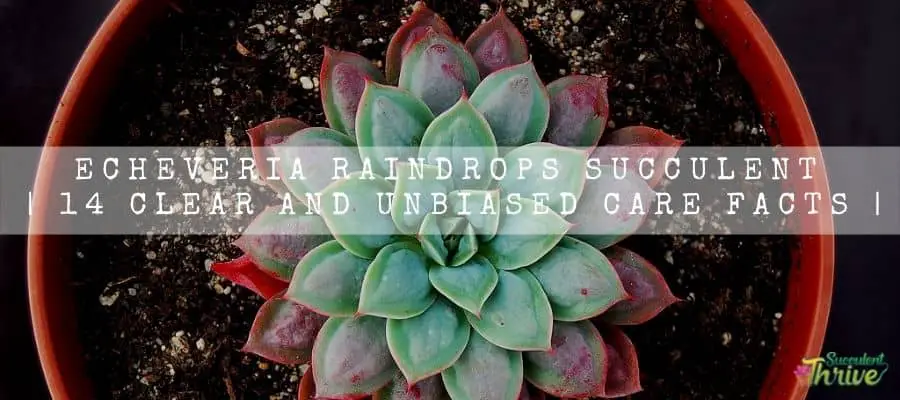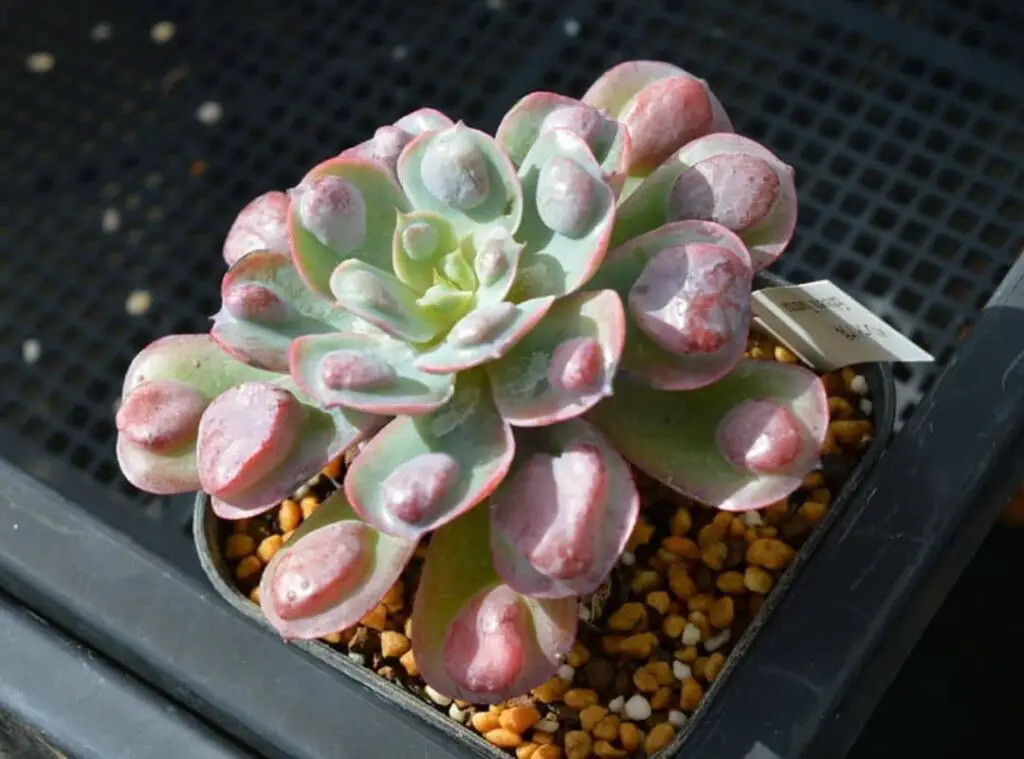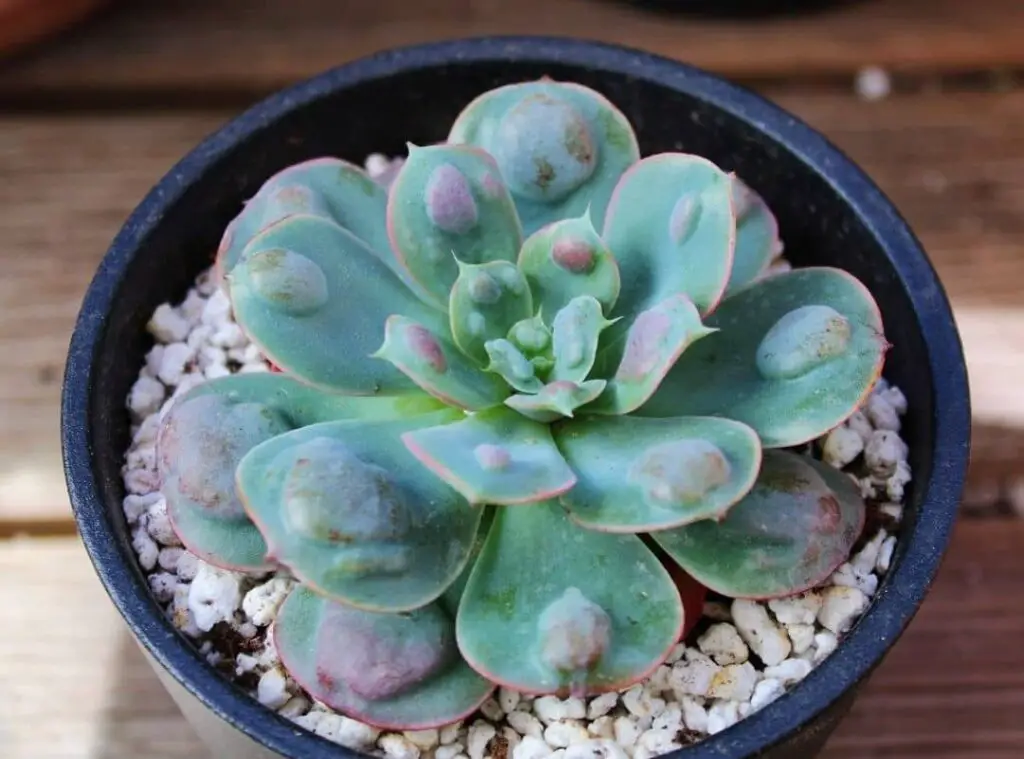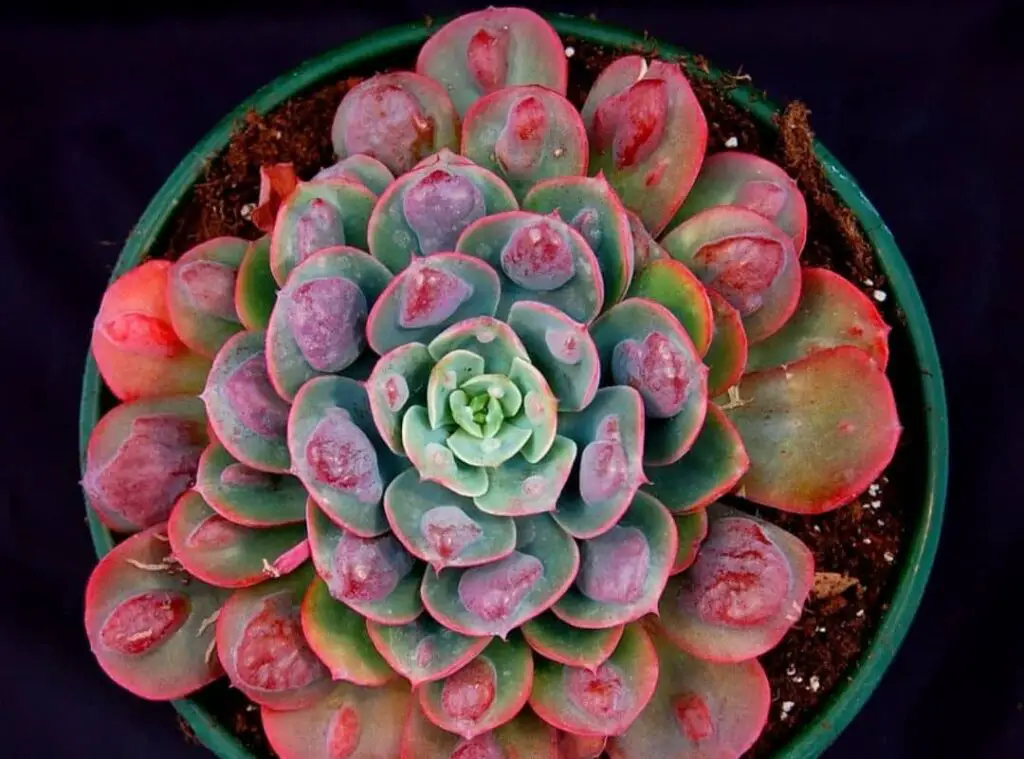Echeveria Raindrops is the most stunning plant among all the Echeveria family. It is such an impressive plant that anybody would want to have.
This is a reddish green succulent and truly one of the prettiest you will find in the entire succulent world.
Due to this reason, many people tend to use them for decorative purposes as well.
Echeveria Raindrops are rosette forming plants. If you already have one of these and are wondering how to care for them the best, you could go through the following article and educate yourself on how to take care of them well.
Echeveria Raindrop’s is in fact a hybrid plant. So, continue reading this article and arm yourself with the caring tips for Echeveria Raindrops.

How do I identify Echeveria Raindrops?
Echeveria Raindrops come up with leaves which are large and round in shape.
Their prominent color is green and when they go through stress properly, their leaf tip color changes from green to red.
When I say going through stress, it could be due to colder weather conditions and due to bright sunlight. Further they comprise a bump around its larger part too.
In fact, these plants inherited the name ‘raindrops’ due to these bumps formation. Literally they look like water droplets and thus the name.
Size of the plant
When it comes to the Echeveria Raindrops sizes, they would reach up to 3-5 inches in height and 5-6 inches in width.
Growth rate
Echeveria Raindrops tend to grow at a moderate speed.
Onelook care guide
| Botanical Name | Echeveria ‘Raindrops’ |
| Common Name | Raindrops Echeveria |
| Plant Type | Succulent |
| Mature Size | 3-5 inches in height and 5-6 inches in width. |
| Sun Exposure | Full Sunlight to partial sunlight |
| Soil Type | Well-draining, sandy |
| Bloom Time | Spring |
| Flower Color | Pink |
| Hardiness Zones | USDA hardiness zones 9b-11b |
| Native Area | Hybrid |
| Toxicity | Non-Toxic |
| Average price | $ 6 |
How do you take care of Echeveria Raindrops?
Light Requirement
Succulents generally prefer to grow under full sunlight and Echeveria Raindrops are no different to them.
Having said that, keep in mind that you should refrain from exposing them to summer full sunlight during intense summer weather conditions.
If you have planted them as house plants and if you suddenly bring them outdoors in extreme full sunlight, it could traumatize the plants.
If you wish to expose them under full sunlight, do it in such a manner where you do not give it a shock. You need to slowly acclimate them to full sunlight.
When you follow those steps, it will give the Echeveria Raindrops plant leaves adequate time to adapt to those conditions slowly. To do that,
- First move the Echeveria Raindrops for morning sunlight for a few hours.
- After that bring to back to indoors
- Keep doing this step while ensuring that you are increasing the exposure of sunlight for them.
- Once you do these steps, it will allow the plants to adjust to stay in full sunlight even during the afternoon hours.
You need to be vigilant on the plants if you are keeping them under strong sunlight levels , chances are that they may go through sunburns.
It could be so irritating as you cannot get rid of them despite what you do.
Unfortunately, they will remain on the Echeveria Raindrops leaves forever and give an unpleasant look for the plants.
On the other hand, if you are going through much colder weather conditions, ensure that you are keeping them near a bright sunny window spot.
Further, if you leave them under low light levels for too long, that will make the plants etiolated and leggy. Hence it is important that you expose them to adequate sunlight levels.

Temperature and humidity
Echeveria Raindrops are fond of growing under summer conditions. You should not bring them indoors except in the colder weather conditions.
So, if there is any forecast of colder weather conditions and if you grow them outdoors, you need to shift them indoors and leave them closer to a bright sunny window spot.
Further if there are colder weather conditions right throughout, the best is to grow them as houseplants.
Echeveria Raindrops prefer to have a temperature around 65-70 degrees Fahrenheit.
Having said that they can also thrive in a minimum temperature of 25 degrees Fahrenheit but not for prolonged periods though. Hence best is to shift them indoors during such conditions.
Is it cold hard?
Echeveria Raindrops are not cold hardy plants and you need to do the aforesaid facts during colder times.
USDA Hardiness Zone
Echeveria Raindrops prefer to grow in USDA hardiness zones 9b-11b ( -3.9 degrees Celsius / 25 degrees Fahrenheit).
Watering Requirement
Echeveria Raindrops also have typical watering requirements just like the majority of other succulents.
However, you should water the soil and do not ever water their rosettes and the leaves at any given point of time.
When you water the soil, it will assure you a fast draining of the excess moisture. Further you need to pour a couple of drinks of water right into the soil and let it wither completely.
However, ensure that you don’t let the top layer of the soil dry, instead ensure that you let it completely dry.
Excess moisture is the biggest enemy of the Echeveria Raindrops plants. We need to ideally let them starve for water. You could consider watering them once every two weeks.
Watering has a greater impact on the Echeveria Raindrops’ vigorous growth. The faults you do during watering is the root cause for many issues of these plants.
There could be signs such as dropping leaves, shriveled leaves or wilting due to faults you do in watering.
Soil Requirement Type / pH
Right soil mix to grow the Echeveria Raindrops should be one which has excellent drainage. That will make sure that excess water is not retained in the pot and do not make waterlogged conditions in the pot.
You may use a cactus soil mix or a sandy potting soil mix to grow them as those conditions will suit them the best.
On the other hand, if you wish to make a soil mix on your own, you could do that as well. You may go ahead with a horticultural coarse sand which will consequently help to have an efficient draining.
Succulents in general are hardy and they can live long. Having said that, you could consider changing their soil mix once every couple of years.
Flowering and Fragrance
Echeveria Raindrops produce flowers in pink. Their flowering season usually falls in spring.
Pot size Potting and Repotting
Watering and growing the plants in a well-draining pot go hand in hand.
Just like the other succulents, Echeveria Raindrops also do not prefer to grow in waterlogged conditions as it will contribute to root rot which could be even lethal on the plants.
As such I recommend growing them in either clay pots or in terracotta pots as they do not retain excess moisture in the pots.
Furthermore, it is essential that your pots have enough draining holes so that the excess moisture could move through.
Echeveria Raindrops do not require repotting on a frequent basis.It could be ideally once every two years. Further you need to repot the newly purchased plants.

Where to Plant
Echeveria Raindrops are dependent on strong sunlight levels. Select a spot where they can gain full sunlight in the morning and partial sunlight in the afternoon.
In addition to that they prefer to have warm weather conditions as well.
You could grow them as outdoor plants if you are someone who is lucky to live in USDA hardiness zones 9b-11b.
On the other hand, if you are going through winter conditions right throughout the year, Echeveria Raindrops would be more suitable as indoor plants.
Further adhere to the aforesaid facts when growing them in pots.
Fertilizer and time of year
You do not need to feed the Echeveria Raindrops a lot. Literally they prefer to grow in soil mix which are quite low in nutrients.
Having said that if you wish to stimulate the growth of the plant you could consider adding some.
However, keep in mind that excess fertilizers could be harmful for them just as the excess water So Chances are that you may not be able to even treat them.
Best is to go ahead with mild fertilizers to feed them. However, when you apply them ensure that you apply them in small quantities so that you could avoid the over feeding of the plants.
Dormancy
Echeveria Raindrops go dormant in winter conditions.
Can be toxic to pets
Echeveria Raindrops are not poisonous for humans as well as for pets. Having said that, I do not recommend consuming them as it could lead to diarrhea, nausea or vomiting.
In case your kids consume any parts of the Echeveria Raindrops plant and show such symptoms, you need to immediately go for a doctor’s opinion.
Common bugs and illnesses
Echeveria Raindrops are usually resistant towards pests and diseases. Having said that there could be occasions where your Echeveria Raindrops may suffer from pests’ attacks.
In that case, you could remedy them with an isopropyl alcohol which is ideally a 70% solution. This will act as a prevention method of any insect attack.
In addition to that, they may also come across root routes as well. Over-watering may cause them to have this condition.
Special Care tips
You could consider pruning the dead leaves if you spot any. That will make sure the Echeveria Raindrops plants thrive well and healthily.
In addition to that,it will allow the plant to protect from pests too. Unless you do not remove them, they will be perfect breeding places for pests.
When you remove the dead leaves, that will make the plants look nice.

How to propagate Echeveria Raindrops
You could propagate the Echeveria Raindrops through four ways such as using their leaves, stem cuttings, seeds and offsets.
Propagation is the most convenient and the affordable way of multiplying these plants and you do not have to purchase them from the stores.
Leaf propagation of Echeveria Raindrops
You could simply choose healthy, fresh leaves for this purpose. Then you may gently twist them off from the mother plant and let them wither for a couple of days.
Next you need to arrange a well-draining soil mix and place them there. You could consider watering them after two weeks’ time whenever their soil is dry.
Stem cutting propagation of Echeveria Raindrops
You could use a matured stem and snip them off whilst using a disinfected pair of scissors or a knife. When you make the cutting, ensure that you are leaving 2 inches from the roots.
Take off the leaves right under the stem and next let them develop calluses for a couple of days. When it is completed, you could plant them in a well-draining soil mix.
Seed propagation
This method is not as easy as other methods. However, you can rely on the successful results of it though. You need to select a good quality Echeveria Raindrops seed when practicing this method.
Once you find good quality Echeveria Raindrops seeds, you need to arrange a well-draining tray along with some well-draining succulent soil mix.
Next lay the seeds in the tray and let them form roots freely. Next is the hardest time as you need to be patient and wait.
This is a little time consuming when compared to other propagation methods. However, when you spot the seeds are ready to replant, you could go ahead and plant them.
Offset propagation
If you are searching for an easy way of propagating the Echeveria Raindrops, you could go ahead with this method.
Echeveria Raindrops usually grow as individual plants. They would require some time to produce bay plants. Hence if you could spot any offset, you need to report them which will consequently allow the roots to grow freely.
To start off, you need to remove the offsets and remove their soil around the base as well.
Next just as in the above methods, let Echeveria Raindrops’ succulents become callous and plant them in a well-draining pot which is filled with a well-draining soil mix.
Conclusion
Echeveria Raindrops is a unique plant which you could grow. On top of that, their easy maintenance is one more privilege of growing the Echeveria Raindrops plants.
As long as you fulfill them, you are fine. You need to pay extra attention to the plants’ watering requirement as well as to their soil mix as both go hand in hand and it has a great impact on the plant’s wellbeing.
Their adorable bumps on the leaves and the green rosettes are the highlights of the Echeveria Raindrops plants. So, Go ahead and try gardening and get the experience on your own!
Read Next : Does Echeveria Perle Von Nurnberg Flower? | 6 Impressive Facts | Echeveria Orange Monroe | 12 Amazing Little Known Care Facts | Echeveria sp el Encino | 11 Mind Numbing Care Facts |
